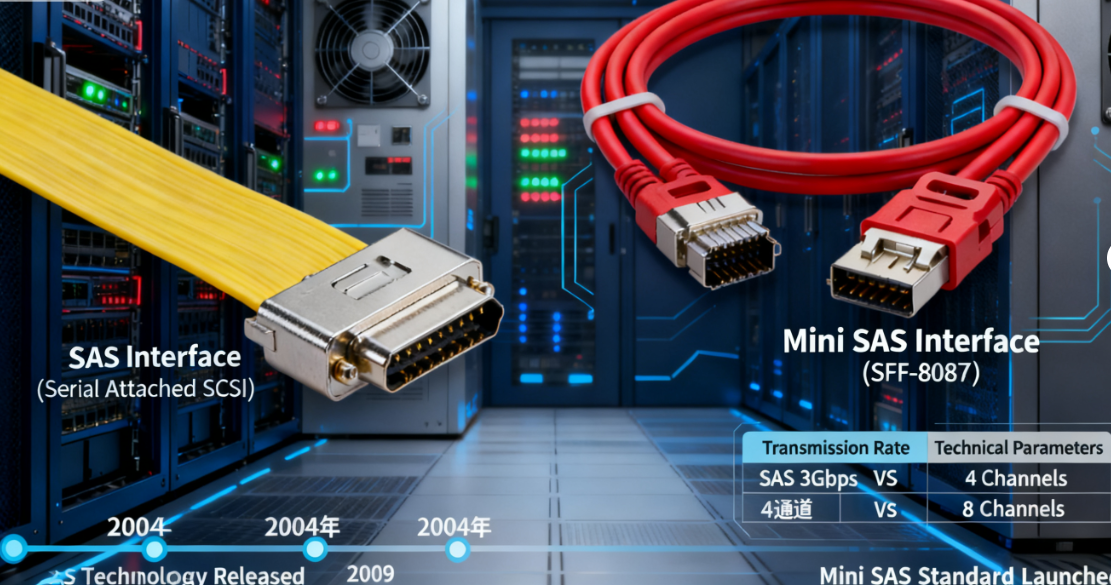What’s the Difference Between SAS Cables and Mini SAS Cables? A Comprehensive Guide to the Evolution of High-Speed Data Center Cabling
In this era of surging data flows, data centers serve as the heart of the digital society, while the high-speed cables responsible for transmitting data between servers and storage arrays are the “lifeblood” keeping this heart beating. Among numerous cable standards, SAS and its evolved successor Mini SAS undoubtedly play a central role. So, what exactly distinguishes these two? Why has Mini SAS become the mainstream choice today?

The Origin of the Lifeline: The Birth and Mission of SAS Cable
SAS, or Serial Attached SCSI, is a point-to-point protocol designed to connect and transfer data to devices such as hard disk drives and tape drives.
Early SAS cables (commonly known as SFF-8484) featured:
Bulky interfaces: Typically featuring four channels per port, resulting in large interface footprints.
Discrete cabling: Multi-link configurations required deploying multiple independent SAS cables, leading to excessive cabling density within cabinets, complex routing, obstructed airflow, and maintenance challenges.
Density limitations: Due to interface size constraints, the number of ports deployable on high-density server and storage device front panels was limited.
Although SAS technology itself delivers high performance and reliability, its external cable form factor has increasingly revealed shortcomings amid the trend toward large-scale, high-density data center development.
Evolutionary Leap: The Innovation and Advantages of Mini SAS Cable
To overcome the limitations of SAS Cable in connector density and cabling flexibility, Mini SAS Cable emerged. It is not a new data transmission protocol but a major innovation in the physical connector form factor of the SAS protocol.
The disruptive nature of Mini SAS Cables (common specifications include SFF-8087, SFF-8088, SFF-8644, etc.) lies in:
High-Density Interfaces: Integrating four or more SAS channels within a smaller physical space, significantly increasing front-panel port density.
Integrated Cabling: A single Mini SAS Cable (e.g., SFF-8088 external cable) replaces four traditional SATA/SAS cables, drastically simplifying wiring while optimizing internal chassis space and thermal airflow.
Performance Integrity: Despite its reduced size, it fully inherits all SAS protocol features, including dual-port operation, full-duplex capability, high bandwidth, and robust error recovery.
Evolution of Mini SAS:
Mini SAS Internal (SFF-8087): Primarily used for internal chassis connections between backplanes and hard drives, representing a revolutionary design that replaces multiple SATA cables.
Mini SAS External (SFF-8088): Designed for external connections between devices, establishing the foundation for high-density external storage connectivity.
Mini SAS HD (SFF-8644): Optimized for the SAS 12Gbps era, supporting higher bandwidth with enhanced locking mechanisms for more secure connections.
SlimSAS/Nano SAS: Further miniaturization beyond Mini SAS to accommodate newer storage devices like NVMe SSDs.
Core Technology Differences at a Glance
| Characteristic Dimension | SAS Cable (Traditional) | Mini SAS Cable (Modern) |
|---|---|---|
| Connector Type | SFF-8484, etc. | SFF-8087, SFF-8088, SFF-8644, etc. |
| Physical dimensions | larger | Compact, high-density |
| Cable Management | Complex, with numerous cables | Concise and highly integrated |
| Number of Channels | Typically, a single cable supports 4 channels. | Single cable integrates 4/8/16 channels for high flexibility |
| Bandwidth Support | Supports SAS 1.0, 2.0 (3/6Gbps) | Fully supports SAS 3.0, 4.0 (12/22.5 Gbps) and higher |
| Mainstream Application Scenarios | Earlier storage systems, servers | Modern servers, high-density storage arrays, JBOD |
| Cost and Maintenance | High wiring costs and inconvenient maintenance | Low total cost of ownership, easy to maintain and replace |
How to Select? Choosing the Right “Bloodline” for Your Data Center
Choosing between SAS and Mini SAS is no longer a dilemma. Follow these guidelines:
1. For new builds and upgrades, go with Mini SAS without hesitation:
For any new server or storage procurement, Mini SAS is now the industry's absolute mainstream and standard configuration. It meets the high-bandwidth and high-density demands for years to come.
2. Consider Compatibility and Transition Solutions:
Despite differing physical interfaces, Mini SAS offers seamless backward compatibility with SATA/SAS drives via adapters (e.g., SFF-8087 to SATA/SAS) or adapter cards, delivering exceptional flexibility.
3. Address bandwidth requirements:
If your system has been upgraded to SAS 12Gbps or higher, you must select cables like Mini SAS HD (SFF-8644) that support the corresponding bandwidth. Traditional SAS cables cannot meet these requirements.
4. Distinguish internal from external:
SFF-8087 is used inside the chassis.
SFF-8088 / SFF-8644 is for external device connections. Ensure you distinguish between them when purchasing.
Technological evolution serves to better support applications. With its absolute advantages of high density, high bandwidth, and easy routing, Mini SAS Cable has completely replaced traditional SAS Cable, becoming the indispensable high-speed data transmission backbone of modern data centers.



